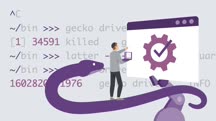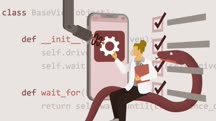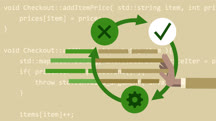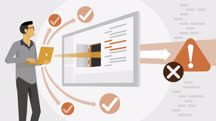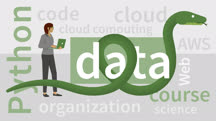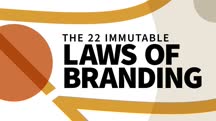Course catalog
Categories
Showing 8,061-8,080 of 9,135 items.
Test Automation with Python: 5 Web Browser Automation with Selenium (234835)
Used correctly, Appium and Selenium can be a powerful force for testing web and mobile apps. This course is part of a series from HeadSpin University that walks you through fundamental concepts of software testing, programming, and ultimately UI automation with Appium and Selenium. This course specifically covers installation and setup. The course begins with how to set up a working Java environment on your development machine. It explores how to download, install, and set up your development environment for Selenium, as well as how to get Appium set up in your local environment. With coding dependencies installed, the course concludes with how to set up your coding environment and start coding your app with Appium and Selenium.
Note: This course was created by HeadSpin University. We are pleased to host this training in our library.
Note: This course was created by HeadSpin University. We are pleased to host this training in our library.
Test Automation with Python: 9 Designing Your Test Suite (234070)
In this installment of the Test Automation with Python, the focus turns from automation to testing. Learn what it means to think like a tester and how to design and run tests on the automation you’ve created with Appium. Key topics covered include knowing what to test so you can run your tests more efficiently, setting up a test runner, working with the page object model, and testing the capabilities of your app on multiple platforms.
Note: This course was created by HeadSpin University. We are pleased to host this training in our library.
Note: This course was created by HeadSpin University. We are pleased to host this training in our library.
Test Prep: GRE
Study effectively for the GRE. This GRE test prep course prepares you for the analytical writing, verbal reasoning, and quantitative reasoning sections of the exam.
Test-Driven Development in C++
Discover how to develop strong, tested C++ code with unit testing and test-driven development.
Test-Driven Development in Django
Learn how to build Django applications using test-driven development.
Test-Driven Infrastructure with Chef
Learn how to develop test-driven infrastructure with Chef. Learn how to perform integration testing and unit testing with ChefDK tools such as Test Kitchen, InSpec, and ChefSpec.
Text Analytics and Predictions with Python Essential Training
Learn about the techniques for analyzing text data in Python and perform machine learning and predictions.
Text Analytics and Predictions with R Essential Training
Learn about the tools and techniques for analyzing text data in R and discover how to perform machine learning and predictions.
Textured Type Techniques
Learn three analog techniques for creating textured typography: hand-cut type, transfer-textured type, and type with a chalky or hand-drawn look.
Texturing a Game Asset in Blender
Learn how to texture game assets—or any other 3D models—in Blender, the open-source 3D rendering software.
The 10 Essentials of Influence and Persuasion (216169)
In today's fast paced, constantly changing workplace, so much of our success comes down to our ability to influence colleagues, persuade co-workers, and get clients and customers to say yes to our ideas, proposals, and requests. But how can you become a more effective persuader? In this course, international best-selling author and persuasion researcher Steve Martin offers up ten proven ways to ethically and practically improve your ability to influence and persuade others at work, at home, and online. Join Steve as he shares his valuable information and action-orientated insights to help you develop and maximize your powers of influence and persuasion and get ready to hear more of the word "yes."
The 22 Immutable Laws of Branding (Blinkist Summary) (217682)
The 22 Immutable Laws of Branding is a practical, hands-on guide to the dos and don'ts of branding as expressed by 22 simple laws: the Law of Expansion, the Law of Contraction, the Law of Quantity, and more. These laws illuminate the all-too-common mistakes made by marketers and showcase the tricks of the trade used by the most successful brands to assert their dominance in ultra-competitive markets. Discover how to narrow your focus for maximum impact, grow intelligently, build trust, develop a powerful logo and brand name, and even reinvent a brand. With these tips, you can build your company, product, or service into a world-class, world-wide brand.
Note: This audiobook summary was produced by Blinkist. We are pleased to host this content in our library.
Note: This audiobook summary was produced by Blinkist. We are pleased to host this content in our library.
The 33 Laws of Typography
Discover how the 33 laws of typography can help you design documents that are beautiful and easy to understand.
The 45-Minute Business Plan
Learn how to create a simple and effective business plan you can take to investors, share with cofounders, or just start executing.
The 5-Day Excel Challenge
Take this fun and fast 5-day Excel challenge to test your Excel skills.
The 52 Best Sales Prospecting Tips (211137)
Have you ever wished for a collection of useful sales and prospecting tips to help you sell more successfully? In this course, sales professional and prospecting coach Miles Croft provides easy-to-understand advice, with actionable and achievable techniques for selling more efficiently, delighting the customer, making the most of your time, avoiding common pitfalls, and much more. With over 50 tips, each one having its own learning objective, you can improve your sales and prospecting know-how by choosing a tip applicable to your specific situation or learning in the recommended order.
This course was created by Miles Croft. We are pleased to host this training in our library.
This course was created by Miles Croft. We are pleased to host this training in our library.
The Accidental Web Designer
Get quick, actionable pointers for creating and managing effective websites—designed for those with no background in web design. Tune in every Wednesday for a new tip.
The Art of Connection: 7 Relationship-Building Skills Every Leader Needs Now (getAbstract Summary)
Enduring relationships help get us ahead at work and find more meaning in life. In this audio-only summary of Michael J. Gelb's book, get insights into building strong connections.
The Art of Leadership (getAbstract Summary) (214537)
Small things that are done well make a difference in your career, particularly if you’re in the role of a manager or leader. This audio-only course, adapted from The Art of Leadership by Michael Lopp, encourages all leaders—from new managers to experienced executives—to sweat the small stuff when hiring, delegating, managing meetings, handling crises, controlling rumors, and more. While many new managers receive no managerial training and must learn by experience, the lessons in this course can give you a head start on your road to becoming a successful, inspiring leader.
This audiobook summary was created by getAbstract, one of the world’s largest providers of business book summaries—with more than 20,000 text and audio summaries in 7 languages. We are pleased to offer this training in our library.
This audiobook summary was created by getAbstract, one of the world’s largest providers of business book summaries—with more than 20,000 text and audio summaries in 7 languages. We are pleased to offer this training in our library.
